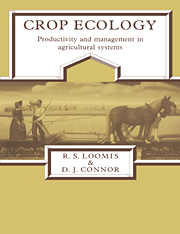Book contents
- Frontmatter
- Contents
- Preface
- Part I Farming systems and their biological components
- Part II Physical and chemical environments
- Part III Production processes
- Part IV Resource management
- 12 Soil management and sustainability
- 13 Strategies and tactics for rainfed agriculture
- 14 Water management in irrigated agriculture
- 15 Energy and labor
- 16 Analysis of wheat–sheep farming in southern Australia
- 17 Mixed farming in the North American Corn Belt
- 18 Towards an uncertain future
- References
- Species list
- Conversions and constants useful in crop ecology
- Index
18 - Towards an uncertain future
from Part IV - Resource management
Published online by Cambridge University Press: 05 June 2012
- Frontmatter
- Contents
- Preface
- Part I Farming systems and their biological components
- Part II Physical and chemical environments
- Part III Production processes
- Part IV Resource management
- 12 Soil management and sustainability
- 13 Strategies and tactics for rainfed agriculture
- 14 Water management in irrigated agriculture
- 15 Energy and labor
- 16 Analysis of wheat–sheep farming in southern Australia
- 17 Mixed farming in the North American Corn Belt
- 18 Towards an uncertain future
- References
- Species list
- Conversions and constants useful in crop ecology
- Index
Summary
INTRODUCTION
The future is uncertain in terms of population, energy supply, weather, and our ability to solve problems. Important issues now are whether agricultural production can be expanded, not just sustained, for the needs of an expanding population and whether that can be done safely. How well we succeed in achieving a sufficient agriculture will depend heavily on the magnitude of population growth and on decisions made about acceptable levels of use of natural resources and energy in food production. Preceding chapters provide some of the basis for possible advances. This chapter reviews trends in population growth and food supply and considers how the challenges of an uncertain future might be met.
POPULATION AND FOOD SUPPLY
Population growth and stabilization
Concepts of carrying capacity have long been evident in the organization of human societies. The English economist Thomas Malthus (1798), however, was perhaps the first to attempt a scholarly analysis of the links between population size and demands on food resources. He concluded that the potential for food production is limited and, if human populations were not controlled by ‘prudence’, they would inevitably be controlled by starvation, war, or pestilence. Malthus was not optimistic about preventive restraints and he and many since have been led to dire views of the fate of mankind.
The intrinsic reproductive capacity of humans, near 40 births per 1000 population per year, is small compared to other animals but, unchecked, it is large enough to allow rapid increases in population size.
- Type
- Chapter
- Information
- Crop EcologyProductivity and Management in Agricultural Systems, pp. 475 - 492Publisher: Cambridge University PressPrint publication year: 1992



